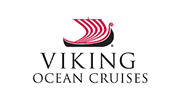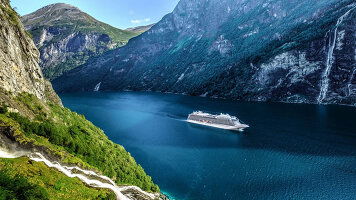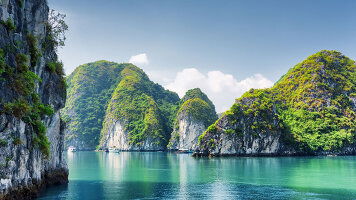Overview
Itinerary
Embark your ship and settle into your stateroom. Cosmopolitan Nuuk is Greenland's capital city and one of the smallest in the world, with just 16,000 residents. Located on the southwest coast, the city is home to one of the world's largest fjords, the Nuup Kangerlua Fjord, whose waters are brimming with marine life; whale sightings are commonplace in these waters. Visitors to Nuuk come to enjoy nature, hiking along the dramatic coastline or exploring the fjord by boat or kayak. Its rugged landscape is dotted with colorful houses, set amid a beautiful backdrop of the Sermitsiaq mountain.
Nuuk's first Inuit settlers arrived on Greenland's shores from the Canadian Arctic approximately 4,500 years ago, and its people have long celebrated their indigenous roots. In the city's boutique stores, knitwear designs are woven with Inuit patterns and local art showcases the blend of modern Danish and traditional cultures. The city's architectural highlights are centered around Colonial Harbor, with its plethora of colorful residences. Nuuk's showpiece however is the Katuaq Cultural Center, which was inspired by the northern lights and surrounding mountain landscapes.
Greenland's west coast is one of the Arctic region's spectacularly scenic highways and a favored transportation route for Greenlanders. Iceberg-filled waters drift past changing landscapes, evoking experiences that were once followed by intrepid explorers for centuries. Alfred Wegener, largely regarded today as the founding father of the theory of continental drift, participated in several expeditions to Greenland. His journey provided the inspiration for John Buchan's 1933 novel, A Prince of the Captivity.
Home to a rich Arctic heritage, Ilulissat sits along pristine waters at the mouth of its namesake ice fjord. The town's colorful houses enjoy a front row seat as icebergs drift by. This endless parade of white floating islands, long studied by glaciologists, has earned the ice fjord status as a UNESCO World Heritage Site. The fjord is fed by the Sermeq Kujalleq—one of the fastest moving glaciers in the world, producing massive icebergs that can be seen drifting out to sea. The town is named for its spectacular scenery; Ilulissat is the local Kalaallisut word for icebergs.
Founded in 1758, the town's heart-shaped mountain looms over the rugged landscape and casts a red-hued glow during summer, thanks to the ever-present midnight sun. Historic buildings line the harbor and the town's history is well-documented at the Uummannaq Museum. The oldest human remains in Greenland were discovered here, preserved for more than 500 years. The Museum pays tribute to Alfred Wegener, who set sail from these shores for his final expedition in 1930. He died on Greenland's ice cap after successfully delivering supplies for a rescue mission.
Sail Baffin Bay, named after Lieutenant William Baffin, who traversed these waters in May 1616. It is an important part of the Arctic ecosystem, covered in sea ice for much of the year, with floating remnants during summer. As you sail today, attend an informative lecture or watch a film on our 8k laser-projected panoramic screen in The Aula, one of the world's most advanced venues for learning at sea. This indoor-outdoor experience allows nature to take center stage with its retractable floor-to-ceiling windows that unveil 270° views.
Pond Inlet sits on the northern shores of Baffin Island at the eastern entrance to the famed Northwest Passage. Home to a small but vibrant Inuit community, it is nicknamed the 'Jewel of the North,' the surrounding Arctic landscape a panoramic mix of glaciers, icebergs and rugged mountains. Pond Inlet is also a gateway to Sirmilik National Park, 'the place of the glaciers' in the local language. Covering more than 8,400 sq mi, the park is a declared migratory bird sanctuary and supports an array of Arctic wildlife, including polar bears, wolves, narwhals and beluga whales.
A region of raw natural beauty, the Canadian High Arctic is characterized by extremely cold temperatures and extended periods of darkness. Explorers long sailed the treacherous waters in search of the famed Northwest Passage; historic Beechey Island is the final resting place for members of the ill-fated Franklin Expedition. Dundas Harbour was once a remote outpost for the Royal Canadian Mounted Police, and became a base for various Arctic expeditions, while Cape Hay features dramatic coastal cliffs, sweeping vistas and unique Arctic wildlife.
Learn about the array of marine life in Baffin Bay, a feeding ground for fish, birds and mammals, including the Arctic cod, Greenland halibut, seals, thick-billed murres and bowhead whales. As you sail today, attend an informative lecture or watch a film on our 8k laser-projected panoramic screen in The Aula, one of the world's most advanced venues for learning at sea. This indoor-outdoor experience allows nature to take center stage with its retractable floor-to-ceiling windows that unveil 270° views.
Greenland's second-largest city is regarded as a gateway to adventure. The town is surrounded by soaring mountains and wide glacial valleys, and a number of beautiful hikes can be enjoyed offering scenic vistas. Several open-air exhibits are on display at the Sisimiut Museum, as well as a collection of 18th- and 19th-century old buildings, the entrances to which are marked by a set of whale jawbones. Traditional kayaks can be seen along the shores, exploring the region as the Inuit do. The origins of the word kayak come from the Greenlandic word qajaq.
Greenland enjoys a diverse food scene and the country's capital encourages visitors to fully embrace the gourmet dining experiences on offer. With most of the country covered in ice, traditional Greenlandic cuisine heavily features seafood, fish and meat. In restaurants serving traditional fare, Suaasat will commonly be found on the menu—a tasty stew of potatoes, onion, rice or barley and meat. A selection of cafés and eateries offer tasting plates or tapas-style dishes, providing a sampler of local delicacies to enjoy, alongside international favorites.
Located at the far end of the Nuuk Fjord, Kapisillit is a quaint village in a sprawling bay with a scenic mountain backdrop. Amid its blue-tinged waters, icebergs drift along as they make their way along the Nuuk Icefjord to the ocean. Several hiking trails weave their way from the town toward the backcountry and along the Kapisillit River, a popular spot for local salmon fishing. It is the only known location in Greenland with a spawning salmon population, and the species found in these waters cannot be found anywhere else in the world.
A small town with a tiny population, Paamiut's residents are friendly and welcoming. The town's local museum is working to restore its 11 historic buildings, including the wooden stave church that was built in 1909. Traditional peat houses can also be explored to gain a glimpse into life here when the early Inuit settlers arrived; they were used to shelter from the extreme winter conditions. Paamiut is also home to the largest population of white-tailed eagles. Majestic in flight, their prowess is a celebrated symbol with youth teams sporting the bird as a lucky mascot.
Ivittuut was founded during the 10th century by medieval Norsemen. By the 19th century, the town was enjoying an economic boom due to its cryolite deposits. The mineral's properties were used to refine aluminum and were integral in the manufacturing of fighter planes. At its peak during World War II, the mine was protected by the Allied forces, with more than 85,000 tons of cryolite being shipped to the US and Canada. It was mined here until 1987 and the community was abandoned soon after. Today, several preserved buildings remain, as well as relics from the town's past.
Follow in the footsteps of intrepid Viking Leif Eriksson who famously crossed this stretch of water to become the first European to land on North American shores. Renew your body, mind and spirit in our Scandinavian-inspired Spa, a Nordic sanctuary of holistic wellness, today while at sea. Whether you unwind in the Sauna, refresh in the Snow Grotto or take a dip in the Thermal Pool, you will feel recharged and revitalized.
Battle Harbour is a small 19th-century village located on a remote island off the coast of Labrador. A vibrant hub for the cod fishing industry from the late 19th to the early 20th centuries, it later fell into economic decline and was abandoned during the decades following a devastating fire in 1930. Today, the island's rugged landscape offers a striking backdrop to the well-preserved heritage structures that dot the restored village serving as a living museum, including narrow boardwalks, traditional saltbox houses and fishing stages.
Red Bay is a small fishing village that sits on a natural harbor on the southern coast of Labrador. Named for the red granite cliffs that dominate the region, the area was a significant Basque whaling station during the 16th and early 17th centuries. Today, the town is both a National Historic Site of Canada and a UNESCO World Heritage Site, offering visitors a glimpse into the past with its well-preserved whaling artifacts, including a whaling ship, the Basque cemetery and a reconstructed 16th-century whaling complex.
Gros Morne National Park is a UNESCO World Heritage Site located on the west coast of Newfoundland. Crisscrossed by hiking trails, the expansive park covers an area of almost 700 sq mi and features diverse scenery and ecosystems, including soaring fjords, rugged mountains, dense forests and coastal lowlands. At 2,600 feet, Gros Morne Mountain towers over its surroundings, while the barren landscape of Tablelands highlights unique geological formations that are more than a billion years old. The park is home to a variety of wildlife, including moose, caribou and black bears.
Havre-Saint-Pierre is located on the northern shore of the Gulf of St. Lawrence, north of the Anticosti Island. Settled by fishermen from the Magdalen Islands in 1857, residents refer to themselves as Cayens and proudly celebrate their Acadian heritage. Historically focused on fishing and lumber, today the village serves as a transit port for ore brought from the mines of Lac Allard. Nestled among the stunning landscapes of the Canadian Shield, this region is a renowned for its diverse flora and fauna, as well as its mysterious, weather-eroded 'monoliths.'
Tadoussac is a small village in the Côte-Nord that sits at the confluence of the St. Lawrence River and the Saguenay Fjord. Established as an important trading post by French explorers in 1599, Tadoussac still retains its rural charms to this day. Surrounded by the rugged natural beauty of the fjord, it is close to several natural and provincial parks, as well as Canada's first maritime national park. A dozen whale species, such as minke, humpback, fins and blue whales, frequent the waters of Tadoussac Bay during the summer months, while beluga whales live here year-round.
Quebec City is by many accounts the most French city in New France. The Old Town's centerpiece, the magnificent Château Frontenac, seems transported from the palatial landscapes of the Loire Valley, and its French-accented streets lead past white-stone buildings that evoke old-world medieval villages. The only remaining walled city in North America outside of Mexico, Quebec City was fortified in the 17th century soon after its founding in 1608. Its strategic setting on the rocky promontory of Cape Diamond gave troops a close view of the St. Lawrence.
Trois-Rivières is the cultural center of Quebec's Maurice region. This picturesque city was established in 1634, the second—after Quebec City, in 1608—to be permanently settled in New France. With its strategic location, it played an important role as all eyes looked west to trade fur with the First Nations peoples. “Three Rivers,” the city's anglicized name, is located at the point where two islands in the Saint-Maurice River break the waterway into three channels before it spills into the St. Lawrence. Today, stately century-old buildings form the core of the Old Town.
A brilliant feat of engineering, the St. Lawrence Seaway comprises a series of locks, canals and channels that allow ships and goods to travel from the Atlantic Ocean up the St. Lawrence River to Lake Superior. Seven locks point the way between Montreal and Lake Ontario, detouring past rapids and several dams. The 27-mile Welland Canal lifts ships over the Niagara Escarpment to Lake Erie, sidestepping Niagara Falls. The Canadian-and American-operated waterway is known locally as “Highway H2O” for the traffic and trade it allows.
Toronto is beloved by many as one of Canada's boldest and most innovative capitals. Hugging the shores of Lake Ontario and facing the picturesque Toronto Islands, it was founded by British loyalists fleeing the American Revolution in 1793. Today the city is a pleasure to explore on foot, whether strolling past the Victorian bay-and-gable homes of Rosedale, or the historic enclave of Wychwood Park, an Ontario Heritage Conservation district. The city's Distillery District is home to North America's largest preserved collection of Victorian industrial architecture.
Toronto is home to a wealth of diverse cultures that each bring their own customs, traditions and food to this cosmopolitan city. More than half of the population were born outside of Toronto and the city's districts represent all corners of the globe; Greektown, Little Italy, Koreatown and Chinatown offer a literal taste of the city's renowned ethnic communities. One of Toronto's historic treasures is St. Lawrence Market, which first operated here in 1803. Today, everything from fresh farmers produce to antiques grace the stalls of its vendors. After breakfast, disembark your ship and journey home.
Life Onboard Viking Octantis
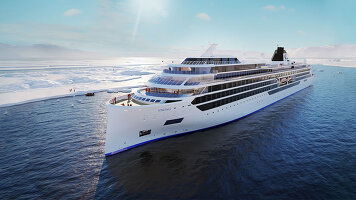
One of Viking's two new expedition ships, Viking Octantis, set off on her maiden voyage in 2022, built specifically for exploration in the world's most remote destinations. Read more
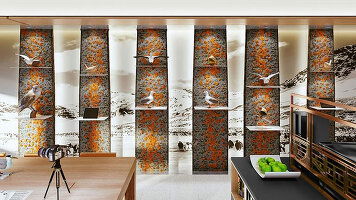
Viking are destination experts. With no casinos or children on board, you can be assured that the focus is firmly on enrichment and education. Read more
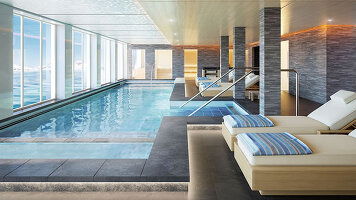
After a day of exploration or just to enhance the relaxation of a day at sea, the on-board Spa will leave you feeling recharged and revitalized. Read more
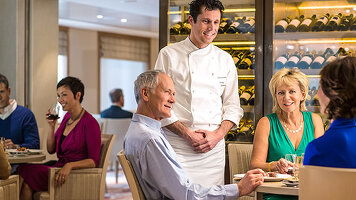
Viking offer six on board dining options. Beer, wine and soft drinks are available with lunch and dinner at no additional charge of fee. Read more

Viking proudly includes all that you need and nothing you do not. A variety of features and services are standard inclusions on your cruise. Read more
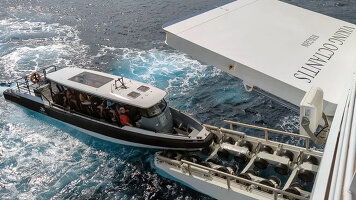
Viking include one complimentary shore excursion in every port of call. Enjoy included experiences around the world. Read more

Trip Reviews (1) Most Recent 'Canada & the Northwest Passage' Reviews
Download Brochure
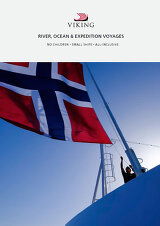
Viking River, Ocean & Expedition Voyages (2025-27)
Dates & Pricing
 USD
USD
Viking Cruise $25 Deposits!
Cabin Layout Options:
Select Cabin Preference:
Tour & cruises prices are per person. Prices shown have savings applied, are subject to availability and may be withdrawn at any time without notice. Pricing and trip details are correct at this point in time, however are subject to confirmation at the time of booking and are subject to change by Viking. For cruise itineraries, cabin images are sourced from the cruise-line and should be treated as indicative only. Cabin inclusions, upholsteries and room layout may differ to the image(s) shown depending on the ship selected and your sailing dates.




